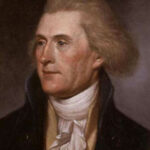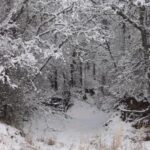We all learned about the Lewis and Clark expedition in school. As you probably know, the expedition of 45 men, led by Meriwether Lewis and William Clark, set out in 1804 to explore the newly-acquired Louisiana Territory, and to report back to Congress on their findings. But here are some of the more interesting things I’ve recently learned that I didn’t already know about the expedition:
1. In all, Lewis and Clark observed and wrote descriptions of 178 plants and 122 species or subspecies of animals. Packets of specimens and reports were sent back to Jefferson from time to time, including a prairie dog in a box — which arrived alive.
2. Sacajawea, besides her service to the group as an interpreter, was useful in other ways. Indians meeting them for the first time concluded that they could not possibly be a war party, since no war party would travel with a woman and child.
3. The expedition did not make a particularly favorable impression on at least some of the Indian tribes. The first tribe of Sioux they met was less than pleased with the presents they gave them — a collection of 5 medals. Things got serious with a tribe of Blackfeet Indians that Lewis’s group encountered on the way back. The Blackfeet tried to steal their weapons in the night, and in the ensuing struggle, two Indians were killed. Lewis’s group managed to cover over 100 miles in one day as they fled from the tribe.
4. Clark’s slave, York, was an interesting member of the party. Although a slave, he was accorded full privileges, even getting a vote in matters that were decided by the party as a whole. (So did Sacajawea.)
He was a great curiosity to the Indians, most of whom had seen white men before, but never black ones. York apparently hammed it up a bit, telling them that before Clark had captured him, he had been wild, and a cannibal, and that children made particularly good eating. (York had been raised from birth by the Clark family.)
When the group returned, Clark settled in St. Louis, keeping York with him. York wanted to return to the Louisville area, where he had a wife and child, and repeatedly asked Clark to grant him his freedom, which Clark refused, citing financial difficulties. Clark became increasingly irritated by York’s requests, and once was said to have given him a “severe trouncing.” Eventually Clark did give him his freedom, and set him up in a drayage business.
6. There was only one death among the members of the expedition: Charles Floyd, who apparently died of peritonitis as a result of a burst appendix.
7. Meriwether Lewis was shot in the thigh at one point by one of his own men, who mistook him for game.
8. Discipline was swift and strict. There are a number of court-martials, mutinies, and disciplinary actions recorded in the accounts of the trip. Among the offenders were John Collins and Hugh Hall, found guilty of stealing whiskey they were supposed to guard, Thomas Howard, of showing Indians how to scale the walls at Ford Mandan, and Alexander Willard, of sleeping while on sentry duty.
9. A Newfoundland dog named Seaman was purchased for $20 by Lewis specifically for the trip. Seaman once was severely injured by a beaver, which had cut several arteries in his hind leg, but was saved through surgery performed by two leaders. The dog was a good hunter and protector, and highly valued by the company. At one point he was stolen by Indians, and Lewis threatened to burn down the village if the dog was not returned.
10. The final tally of expenses to the government was nearly $39,000. The cost had been estimated by Jefferson (and allocated by Congress) at $2,500. I guess some things never change.



